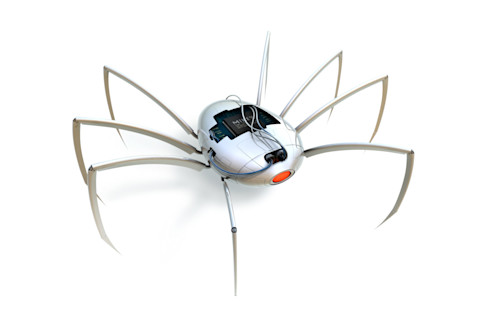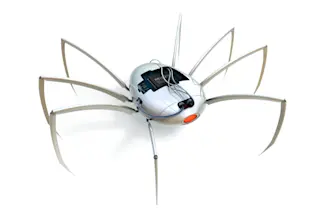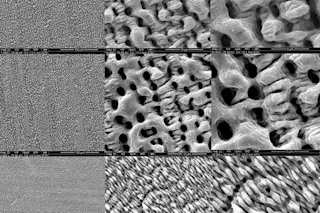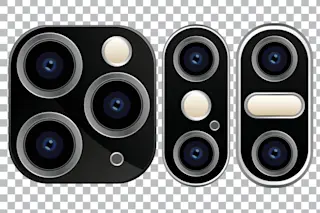
Paul McEuen, professor of physics at Cornell University and director of the Kavli Institute at Cornell for Nanoscale Science. | Michael Okoniewski
In the 2011 thriller novel Spiral, a scientist is forced to swallow a swarm of razor-clawed, fungus-tending micro-robots, a scene that hardly presents small machines in a positive light. So it may seem odd that the book’s first-time author, 49-year-old physicist Paul McEuen, is a leader in the field of nanoscience, the study of structures smaller than a micron, or a millionth of a meter.
One might think his fellow scientists would be disturbed that he mined his field for gory ways to kill people. “Actually,” McEuen says, “they were very supportive. I even got a good review in the Journal of Mycology.” Relaxed, thoughtful and highly literate — in a recent academic article he cited Hume, Joyce and Beckett along with Nobel Prize-winning physicists Richard Feynman and Niels Bohr — McEuen is a man of wide-ranging interests who has narrowed his scientific focus to the very, very small.
McEuen was already a leading authority on carbon nanotubes, naturally occurring cylindrical structures smaller than a billionth of a meter in diameter, when he was lured to Ithaca, N.Y., in 2001 to direct Cornell University’s Laboratory of Atomic and Solid State Physics. In 2010, he also took over as director of the prestigious Kavli Institute at Cornell for Nanoscale Science.
Today, he spends many of his workdays exploring the properties of graphene, the world’s thinnest material at just one atom thick. Sixteen faculty and their research groups are involved in the institute he runs, creating tools that will one day build and control nanobots and other atomic-scale machines still the stuff of science fiction. One ambitious multibillion-dollar effort that McEuen is helping to plan will use nanomaterials to listen in on millions of brain cells at once.
When he’s not investigating atomic-scale objects in his lab, McEuen tinkers with his next thriller manuscript in the home he shares with his psychologist wife, Susan Wiser, and their six dogs. DISCOVER sent writer Doug Stewart to Ithaca to ask McEuen about where nanoscience is headed. The nonfiction future, to hear McEuen tell it, is a world of bloodstream submarines; tiny, flexible computers; and thinking small.
Have you always been drawn to tiny things?
I remember being fascinated by ants and wasps and other bugs when I was a kid. I’d set out a Coke can and stand back 20 feet and use my telescope to watch wasps land on it. Here were these amazing little bitty machines that could do all sorts of things. I think it’s very telling: I got this telescope to look at the stars, but I ended up using it to look at small things. Even at the time that’s where my interests lay — that extra universe that exists at the small scale rather than the big scale.
But you didn’t end up deciding to become an entomologist.
No. As an undergrad, I studied engineering physics at the University of Oklahoma, and all my degrees are from engineering departments. My father wanted me to join him in the oil-field business in Oklahoma, but I wanted to be a scientist. Later, when I was thinking about graduate school, I read about a professor at Yale named Robert Wheeler, who was making tiny one-dimensional conductors and transistors — really skinny wires, basically. I didn’t know what that was, but I thought it sounded really cool. He became my Ph.D. adviser in the late 1980s.
What excited you about the skinny wires?
There was a sense that an unexplored world was just opening up. If devices are small enough, the effects of a single electron start to matter. At MIT, where I did postdoctoral work, we made transistors that were so small there were only one or two or maybe three electrons in them. Transistors are used to turn on and off the flow of electrons through a device, and also to amplify that flow so that you can send one signal to many devices. They’re the building blocks of computers. The smaller you can make a transistor, the faster it is.
This was your first foray into atomic-scale technology. What does nanotechnology encompass, and why does it matter?
Nanotechnology is the idea that we can create devices and machines all the way down to the nanometer scale, which is a billionth of a meter, about half the width of a human DNA molecule. In the case of electronics, nanoscience has already pushed it down to the nanoscale — we’ve been able to pack incredibly dense arrays of devices on chips. The goal is to make machines at that scale that will do real work.
After you joined the faculty of the University of California at Berkeley in 1992, your attention turned to carbon nanotubes, carbon cylinders 10,000 times narrower than a human hair. What happened?
Carbon nanotubes occur naturally — we now know you find them in soot. When I was at Berkeley, Richard Smalley, a Rice University chemist, was learning how to grow large quantities of carbon nanotubes in his lab. We thought, “Let’s try wiring up some of those.”
What was it about these nanostructures that excited you?
Carbon nanotubes are amazing because they’re really good electrical conductors, yet they are only a few atoms in diameter. You can make transistors out of them in the same way you can with silicon. At Berkeley, we made the narrowest device anybody had ever made. It was basically a single molecule. It is fundamental science like this that underpins the applications that are coming.
Can you describe those applications? How might carbon nanotubes be used?
One approach is to use them to make high-performance, small devices that would replace silicon. You could use them the same way as you would a silicon transistor but with higher performance — like silicon transistor chips. IBM is working on things related to that. And because they’re so flexible, you can use them for high-performance, flexible electronics, so if you want your electronics to be on a flexible screen, it might be useful for that. They might also be useful for nanoscale sensors: They’re so small that even if a single molecule sticks to them, it can change the conducting properties, allowing you to sense the presence of individual molecules.
Since 2001, you’ve been at Cornell. What are you investigating?
Lately we’ve been working on graphene, which is a sheet one atom thick, made entirely of carbon atoms arranged in a hexagonal structure like chicken wire. You can think of it as a carbon nanotube that’s been rolled out flat. Unlike nanotubes, you can make it cover large areas, you can make it more uniform, and it’s much easier to work with as a material — it’s as different [from nanotubes] as a sheet of paper is from a stick.
Graphene is a phenomenal material in almost every way. It’s electrically conducting, so it could be useful in electronic devices. It’s incredibly flexible, so something that handles like a piece of paper could actually be an electronic display. When you push a single sheet of graphene with a probe, it crinkles up a little like cellophane, but it doesn’t rip. In fact, both graphene and carbon nanotubes are extremely strong. You can do all sorts of nasty things to them — pour acid on them, keep them underwater — and they don’t mind.

In his 2011 novel Spiral, Paul McEuen envisioned swarms of miniature servants in the form of micro-robots like this one. | Dial Press
How is graphene’s durability useful?
It means it can survive all kinds of environments and not break down, which is hard to do at the nanoscale. Most of the nanomachines in your body — by that, I mean biological machines like enzymes — don’t last more than a few hours. They’re constantly replaced in your body as they break down chemically. If you want a device to work inside your body for years, like a brain implant, durability is essential.
What kinds of nanomachines could arise out of basic research on graphene?
Since nanomachines don’t exist yet, we can’t say what they’ll look like. You might think that they would look like miniature versions of machines we know, so if you were building a tiny machine that was going to move around in the bloodstream and look for cancerous cells, it might look like a little submarine. But it’s more likely that it would look like its biological equivalent: a bacterium, with soft movable parts that flex to cause it to swim, and a little propeller.
What are you working on?
The structures we work with are the elements out of which you would build these machines — the panels and screws, you might say. Lately, we’ve been making lots of tiny graphene resonators. They’re basically drumheads an atom thick. It’s fascinating to make what amounts to the world’s thinnest drum, to see if you can put it into vibration and play it and listen to it.
You can tune nanodrums just like a real drum, depending on how much tension you put in the membrane. They vibrate at the frequency of an FM radio signal, so they could be used for miniaturized communications systems. For example, if you wanted to make a bloodstream submarine, you’d need to get information in and out. A graphene resonator on board could tune to signals at a particular frequency, the way a cell phone does, but it would be extraordinarily tiny and use very little power.
You’ve also been designing hinges made of graphene, which would be a necessary part of any kind of nanoscale machine. How do graphene hinges work?
A traditional door hinge is a complicated device with a lot of parts, so it’s hard to build — you have to build all those pieces and know how to put them together, and that’s not easy to do. A graphene hinge is more like a paper fold. We made one hinge that we tested by opening and closing it about 10,000 times to show that it’s indestructible with normal use.
With hinges like that made out of silicon, you might build an array of tiny steerable mirrors that would change the colors and reflectivity of pixels in a new kind of TV screen. Or, if you built a nanosubmarine, you might want to seal a drug inside for delivery to a cancer cell that you wanted to kill. A hinged graphene door could then open and release the drug on the spot. You could plan multiple folds, like an origami design.
You’ve been involved in designing ways to use nanoscience tools to understand the brain better. What is the main goal?
The medical world would like flexible brain implants so they can shove them between the brain’s ridges or corrugations and get back signals from deep inside the brain. A flexible electronic implant might help a person control a prosthetic limb, for example. We’ve done no actual work on this yet — we’re thinking ahead.
What’s a key challenge in designing such brain implants?
One is that you want the wires to be small enough that they don’t cause brain damage when you jam them in. But if they’re too small, it’s hard to insert them — it’s like pushing a rope. What you really need is a little semi-autonomous device that knows how to crawl down into the crevices in your brain, dragging its little electrical or optical wire behind it, attach it to the right place, come back out, grab another wire, and so on. This is science fiction right now, but it could happen.
No wonder you’ve begun writing in the science fiction genre. Your novel Spiral features homicidal “MicroCrawlers.” Did you worry about damaging nanotechnology’s image?
I probably worried more about damaging my own reputation as a scientist. But I figured what the heck — Jurassic Park probably drew more people to science than scared them away. Anyway, people expect thrillers to be over the top.
Did you see your MicroCrawlers as benign machines gone astray, or did you intend them to be creepy?
I definitely went for creepy. They are basically robotic spiders. In fact, my wife has a fear that if she sleeps with her mouth open, a spider might drop in. That might be where I got the idea of these tiny robots getting inside people.
Did you yourself ever accidentally inhale a nanodevice?
They’re so small I wouldn’t notice. In any case, if I lose something or it doesn’t work, there’s always another one. That’s an advantage of working with tiny things: You make them by the millions.
[This article originally appeared in print as "Thinking Small."]















